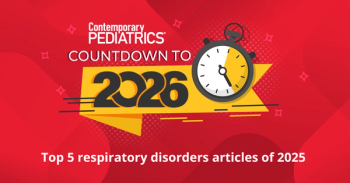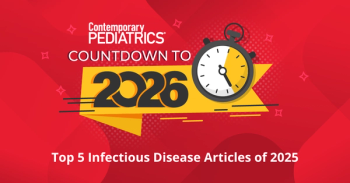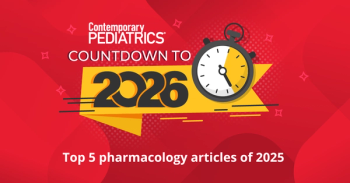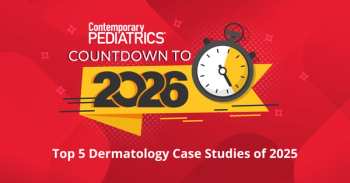
Advancing pediatric health: Key updates and clinical insights from the first half of 2025
A look back at the most important FDA approvals, clinical research, and expert perspectives shaping pediatric health care in the first half of 2025.
The first half of 2025 has been marked by significant regulatory milestones in pediatric medicine, with the FDA advancing new therapies, diagnostic tools, and preventive strategies across a range of conditions affecting children and adolescents.
Key approvals include needle-free epinephrine for anaphylaxis, new monoclonal antibodies for RSV and hereditary angioedema, and the first treatment for hyperphagia in Prader-Willi syndrome. Promising clinical trials have also driven innovation in atopic dermatitis, ADHD, and pediatric food allergies, while new vaccines and delivery systems aim to improve protection against meningococcal disease and chikungunya virus.
In this comprehensive recap, Contemporary Pediatrics highlights the most impactful FDA decisions, clinical trial updates, and expert insights shaping pediatric care in 2025.
2025 regulatory updates in pediatrics
FDA approves neffy 1 mg for anaphylaxis in children aged 4 years and older
The FDA approved epinephrine nasal spray (neffy; ARS Pharmaceuticals) 1 mg on March 5, 2025, for children aged 4 years and older weighing 33 to 66 lbs, making it the first needle-free epinephrine treatment for younger pediatric patients. This expands its indication beyond the original August 2024 approval for patients weighing at least 66 lbs.
Expected to launch in the United States by May 2025, neffy offers a user-friendly, temperature-stable alternative to traditional epinephrine auto-injectors, addressing fears of needle-based administration that often delay treatment. Approval was based on pharmacokinetic and pharmacodynamic data showing comparable efficacy to injectable epinephrine.
FDA accepts new drug application for vatiquinone to treat Friedreich's ataxia
The FDA has accepted PTC Therapeutics' new drug application (NDA) for vatiquinone to treat Friedreich's ataxia (FA), granting it priority review with a target action date of August 19, 2025. If approved, vatiquinone would be the first therapy for pediatric FA patients and a potential treatment option for adults.
The NDA is supported by data from the MOVE-FA trial and long-term studies, demonstrating that vatiquinone slows disease progression and is well tolerated. The drug inhibits 15-Lipoxygenase (15-LO) to mitigate mitochondrial dysfunction and oxidative stress, key factors in FA. Clinical trial results showed benefits in fatigue reduction, neurological symptoms, and mobility preservation.
FA is a rare genetic neuromuscular disorder affecting approximately 25,000 people worldwide, with no approved treatment targeting disease progression.
FDA approves GSK's meningococcal ABCWY vaccine
On February 14, 2025, the FDA approved the meningococcal ABCWY (MenABCWY, Penmenvy; GSK) vaccine for individuals aged 10 to 25 years, offering protection against the five major serogroups (A, B, C, W, Y) of Neisseria meningitidis, which cause invasive meningococcal disease (IMD).
The vaccine combines components of the meningococcal group B vaccine (Bexsero) and the ACYW conjugate vaccine (Menveo). Approval was based on a phase 3 trial (NCT04502693) involving 3,650 participants across seven countries, demonstrating strong immunogenicity, non-inferiority to existing vaccines, and a well-tolerated safety profile. MenB accounts for over half of IMD cases in Sadolescents and young adults, yet vaccination rates remain low.
FDA approves clesrovimab to protect infants during first RSV season
On June 9, 2025, the FDA approved Merck’s clesrovimab (Enflonsia), an extended half-life monoclonal antibody, to protect infants from respiratory syncytial virus (RSV) during their first RSV season. The approval was supported by positive results from the phase 2b/3 CLEVER and phase 3 SMART trials, which demonstrated that a single dose of clesrovimab significantly reduced RSV-related infections and hospitalizations in both healthy and high-risk infants. In the CLEVER trial, clesrovimab reduced medically attended lower respiratory infections by 60.5%, RSV-related hospitalizations by 84.3%, and severe RSV cases by over 90% through 5 months post-dose (P < 0.001 for all). Unlike other monoclonal antibodies, clesrovimab targets site 4 of the RSV fusion protein, neutralizing more than 96% of RSV A and B strains. The therapy, given as a fixed intramuscular dose, offers direct, rapid, and durable protection throughout a typical RSV season.
FDA approves garadacimab-gxii to prevent HAE attacks in patients aged 12 years, older
On June 17, 2025, FDA approved CSL’s garadacimab-gxii (Andembry), a first-in-class monoclonal antibody targeting factor XIIa, to prevent hereditary angioedema (HAE) attacks in patients aged 12 years and older. Approval was based on the phase 3 VANGUARD trial, where once-monthly garadacimab-gxii reduced mean HAE attack rates by 86.5% and median attack rates by over 99% compared to placebo (P < 0.001). An open-label extension study also showed sustained efficacy and a favorable long-term safety profile. Experts highlighted its novel mechanism and convenient dosing as key advances for HAE management. Meanwhile, FDA review of another HAE therapy, sebetralstat, has been delayed due to resource constraints, though no concerns about its safety or efficacy were raised.
2025 trial announcements in pediatrics
Roflumilast cream 0.05% demonstrates eczema area severity, itch improvement for pediatric atopic dermatitis
On February 24, 2025, Pediatric Dermatology published phase 3 INTEGUMENT-PED trial (NCT04845620) data showing that roflumilast cream 0.05% (Zoryve; Arcutis Biotherapeutics) improved eczema severity and itch in children aged 2 to 5 years with atopic dermatitis (AD).
At week 4, 25.4% of treated children achieved validated Investigator Global Assessment-Atopic Dermatitis (vIGA-AD) success vs. 10.7% with vehicle (P < 0.0001), and 39.4% reached EASI-75 improvement.
Rapid itch relief occurred within 24 hours (P ≤ .0014). Findings supported Arcutis’ December 2024 FDA submission for approval. If approved, roflumilast 0.05% would offer a steroid-free, once-daily treatment for young children with AD.
Omalizumab outperforms oral immunotherapy in treating multi-food allergy
On March 2, 2025, results from the OUtMATCH trial showed that omalizumab (Xolair; Genentech, Novartis) was more effective than oral immunotherapy (OIT) in treating multi-food allergy.
Among all participants, 36% of those receiving omalizumab tolerated at least 2g of peanut protein and two other allergens, compared to 19% in the OIT group. High rates of allergic reactions led to a 49% dropout rate in the OIT group, while none discontinued omalizumab due to severe reactions. Omalizumab, which reduces immune sensitivity by targeting IgE, may offer a well-tolerated alternative to OIT for food allergy treatment.
Cingulate reports phase 3 safety data for CTx-1301 to treat ADHD in children, adolescents
On March 4, 2025, Cingulate Inc. announced phase 3 safety data for CTx-1301 (dexmethylphenidate), a once-daily stimulant for ADHD designed to provide full-day symptom control.
Findings from two pediatric trials showed no serious adverse events, supporting the company’s planned FDA submission in mid-2025. CTx-1301 delivers three precisely timed doses in a single tablet, potentially addressing adherence issues and side effects linked to multiple daily doses.
Cingulate was scheduled to meet with the FDA on April 2, 2025, for a pre-NDA meeting, with a full submission expected in the summer of 2025.
Bavarian Nordic initiates trial of chikungunya vaccine in children aged 2-11 years
On June 12, 2025, Bavarian Nordic initiated a phase 3 clinical trial of its single-dose, virus-like particle (VLP) chikungunya vaccine, Vimkunya, in children aged 2 to 11 years. The global, randomized, double-blind, placebo-controlled study will assess the vaccine’s safety and immunogenicity in 720 participants over 2 years, with primary results expected in 2028. Vimkunya, already FDA-approved for individuals aged 12 and older, was launched in March 2025 and is the first VLP chikungunya vaccine available for that age group. The pediatric trial reflects the company’s effort to expand access to protection amid increasing global transmission of chikungunya.
Dupilumab improves atopic dermatitis severity in adolescents, adults with skin of color
Announced June 9, 2025, the phase 4 DISCOVER trial, dupilumab (Dupixent; Regeneron and Sanofi) showed significant clinical benefits in patients aged 12 years and older with moderate-to-severe atopic dermatitis (AD) and skin of color. Among the 120 participants, 82% of whom were Black, 76% achieved at least a 75% improvement in disease severity (EASI-75) at 24 weeks, with many seeing results as early as 2 weeks. Dupilumab also improved itch in 53% of patients and reduced post-inflammatory hyperpigmentation by 53%. The trial is the first large-scale study of its kind in this population and highlights dupilumab’s potential to address both the physical and quality-of-life impacts of AD in underserved communities.
2025 expert perspectives in pediatrics
In this section, click the "play" button on each video interview to watch.
Tina Tan, MD discusses the increased outbreaks of norovirus this year
In this video interview, Tina Tan, MD, FAAP, FIDSA, FPIDS, highlighted the alarming rise in norovirus outbreaks, with CDC data showing 495 outbreaks from August to December 2024.
Tan, an infectious diseases expert at Lurie Children's Hospital and president of the Infectious Diseases Society of America, explained that norovirus spreads easily through contaminated food, surfaces, and direct contact, particularly in schools and daycare centers.
Tan stressed the importance of proper handwashing—since hand sanitizers are ineffective—along with food safety measures to curb transmission. Pediatricians play a key role in educating families on hygiene practices to prevent infection.
RX Review: Advances in pediatric food allergy and anaphylaxis treatment
In this Contemporary Pediatrics and HCPLive RX Review video discussion, Brian Schroer, MD, an allergist-immunologist at Cleveland Clinic Children's Hospital, moderated a panel on the latest advancements in pediatric food allergy care. Joined by Colleen Kraft, MD, of Children's Hospital Los Angeles, and Russell Traister, MD, of Allegheny Health Network, the experts discussed the shift toward early allergen introduction, the growing role of oral immunotherapy and intranasal epinephrine, and the impact of Xolair (omalizumab) in treating food allergies. They highlighted the importance of personalized management plans to enhance diagnosis, treatment, and long-term patient outcomes.
RX Review: RSV prevention and pediatric hospitalization
In this HCP Live Network RX Review roundtable, Albert Rizzo, MD, of the American Lung Association, moderated a discussion on the evolving landscape of RSV prevention in pediatric care. He was joined by Tina Tan, MD, of Lurie Children's Hospital, and Joanne Nazif, MD, of Children’s Hospital at Montefiore. The panel explored the clinical impact of recent advancements such as maternal RSV vaccination and monoclonal antibody use. Tan noted reductions in RSV-related hospitalizations and disease severity in infants, particularly after the introduction of nirsevimab, while Nazif emphasized that treatment options remained limited, making prevention all the more critical. The panel also reviewed shifting RSV trends following the COVID-19 pandemic and highlighted early data from the 2024–2025 season showing declines in infant hospitalizations, suggesting improved outcomes through proactive prevention strategies.
Newsletter
Access practical, evidence-based guidance to support better care for our youngest patients. Join our email list for the latest clinical updates.




